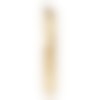Making the Task Knife
The task knife comes to life via a combination of in-house and out-of-house manufacturing—by working with talented local vendors, as well as leveraging our own manufacturing strengths, we tightly control the process and outcome, to deliver a high-quality product you can’t find anywhere else.
The Solid Metal Knife
The task knife starts out as a 3/8" inch thick billet of metal—first, the geometries of one side are machined away, then the knife is flipped and the symmetrical face is machined as well. We work with local machinists in the Portland area in order to guarantee the highest quality and to work in smaller, leaner batch sizes.

Machining metals is no easy task, especially with the sculptural forms we designed in the task knife. To create the sweeping geometry of the blade, we had to use non-traditional knife making methods, which is why the curving blade looks so unique. Once the knife is machined, it comes back to our shop for rigorous quality control.

With the brass and stainless steel version, the finish quality has to be excellent—generally, machined metals are post-machine treated, via tumbling or bead blasting, to create a uniform surface appearance. Because we've designed our task knife to show off the raw machined marks, we have an incredibly stringent quality checklist—basically, nothing gets covered up. The black knives are sent to a local vendor to get coated in a durable ceramic coating found in high-end firearms.

The task knife is designed for very light duty, so the blade geometries require minimal upkeep—used as intended, the blade shouldn't have to be sharpened for a long, long time. Our minimalist knife uses high performance 440C blade steel, if that suits your needs better.
The Hardwood Stand
To complement the all-metal knife, we designed a subtle, sculptural stand in walnut or maple. The stand is manufactured almost entirely in our shop. It starts at the CNC mill, where the complex curves and overall shape are cut from the wood.
The wood is glued to the aluminum base plate. Then, off for a combination of belt and hand sanding, to soften the edges and smooth the surface, and bring the metal and the wood perfectly flush.
Finally, hand applied oil and wax finish goes on, to preserve and make the grain pop.

The final step of assembly for the brass knives is a hand-polish, to make them shine. The brass will patina beautifully over time, as you use it.

We apply a cork foot on the bottom of the stand to protect your desk, and check to make sure the knife nestles perfectly in the stand. We make the custom packaging in-house, and then it’s out the door and on its way to its new home.

Works Alone
Let the machining shine in raw brass or stainless steel, or go for the matte look with a black ceramic coating.












